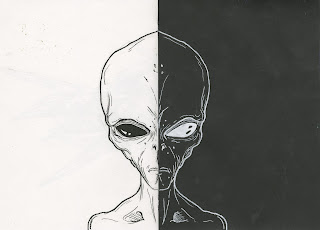I originally had this cosmic sky with the silhouette as my final landscape editorial design. After completing this image I was not satisfied at all, It didnt take me long and I already knew what the final outcome would look like before I had started. I felt like I wasn't pushing myself to create something totally new so I decided to go back and redesign the whole landscape image.
As my other two formats for this brief both included astronauts, I thought the best thing to do was include astronauts across each of them so they work together as a set. I then went back to my sketches and refined my astronaut drawings and arranged them onto the landscape format. My original intention was to just have a simple black and white image of the astronauts but again I always create work using black on white so this was nothing new to me, I hadn't discovered anything and also this image of astronauts does not have an editorial aesthetic, it needs to be changed.


The two cosmos space textures above are actually the same image but the the brighter one has been scanned into photoshop and slightly edited, adjusting the levels and enhancing the brightness and contrast which are simple tricks that can really increase the overall quality of the image. My original plan was to craft all of my editorial designs using only analogue media but I have now realised that combining both digital with analogue can really enhance the quality to make a more professional and refined outcome.

After discussing the astronaut drawing with classmates and rethinking it myself, I have tried to combine the drawing with the space background. This has been done by inverting the original drawing into white and cropping out all of the unnecassary, then layering that on top of the space texture. I am so glad that I did this as a last minuet decision because I think the outcome looks a lot better than the drawn version and I have also learned some new digital skills that I'm sure will only progress now i am eager to use more digital tools to improve my practice.

I was looking at the astronaut image and I thought that the white helmets looked to blocky and full so I rubbed out the white and let the space texture show through but inverting the glare into white highlights. I think after doing this, the image becomes a lot easier to look at and the astronauts seem to become more part of the whole image rather than just being a separate layer on the top. I now realise that these slight digital adjustments can make such a big difference to the aesthetics of an image.
 |
| 1. |
 |
| 2. |
 |
| 3. |
After I had completely changed the way the landscape design looked, I wanted to do the same to the portrait as it would look better as a set and also the digital tools would allow me to create a more refined outcome.
3. was my first final design. It has been made from white pen on black paper, then cut out and stuck onto the cosmic background. While I was quite happy with the outcome I thought that the digital tools would definitely help me to enhance the image.
2. Is the same image but with the levels, brightness and contrast adjusted to bring out the light tones and darken the dark. This contrast make the image more vibrant. I have also got the image without the planet in the background, I Think the planet removed looks slightly better and reduced, plus its a little cliche to just have a planet with the astronaut, I wanted to bring more aspects of Carl Sagan into the design.
1. now has a piece of sacred geometry in the background. I have done this in the same way as the four astronauts, I drew the geometric shape in pencil and then inverted that to white and layered it onto the space background. I think that this works better than the planet because it is more of a subtle shape and the geometry relates more to Carl Sagan so for the editorial its more appropriate.



















































